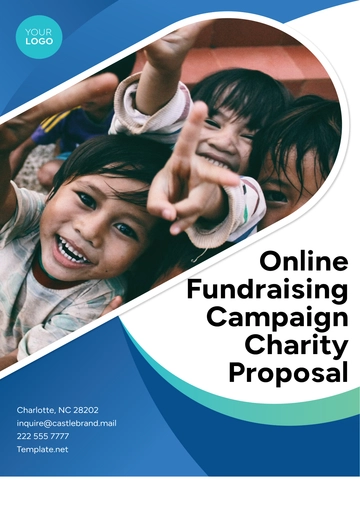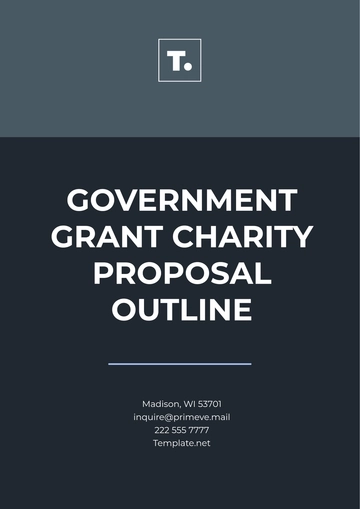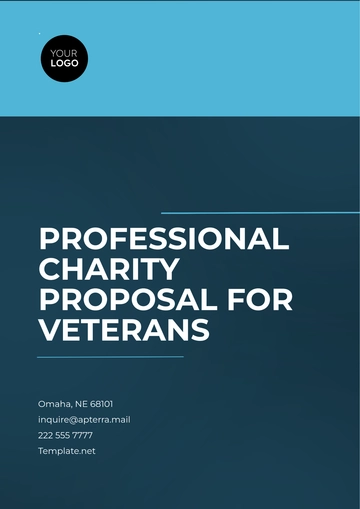Free Charity Proposal

Introduction
Education is a fundamental right, yet millions of children worldwide lack access to quality learning resources due to economic challenges. This proposal outlines an initiative to provide free educational materials, training, and facilities to underserved communities. By addressing the root causes of educational inequality, the initiative strives to create opportunities that empower future generations.
Objective
The primary objective of this initiative is to ensure that underprivileged children receive quality education by:
Establishing community learning centers.
Distributing free educational materials, including books, stationery, and digital learning tools.
Providing teacher training to improve education delivery.
Proposed Activities
1. Community Learning Centers
Description: Set up accessible learning spaces with books, computers, and other resources.
Location: Targeting rural and urban low-income areas.
Timeline: Within 12 months of funding approval.
2. Distribution of Educational Materials
Description: Distribute books, notebooks, writing tools, and tablets with preloaded educational content.
Beneficiaries: At least 1,000 children in the first year.
3. Teacher Training Programs
Description: Conduct workshops to enhance teaching skills and methodologies.
Target Audience: Local educators and volunteers.
Duration: 6 months.
Budget Overview
Activity | Cost (USD) |
|---|---|
Community Learning Centers | 50,000 |
Educational Materials | 25,000 |
Teacher Training Programs | 15,000 |
Total | 90,000 |
Impact
This initiative will:
Enable at least 1,000 children to access quality education in the first year.
Enhance teaching quality for educators through comprehensive training.
Foster long-term community development by addressing educational disparities.
Call to Action
We invite you to join this transformative journey. Your support can make a lasting difference in the lives of these children and their communities. Donations, sponsorships, or collaborations are welcome to bring this project to life.
For inquiries or further details, please contact: [YOUR NAME]
[YOUR EMAIL]
[YOUR COMPANY NUMBER]
Conclusion
This initiative is more than a project; it is a mission to create opportunities and break the cycle of poverty through education. Together, we can make a tangible impact and pave the way for a brighter future.
- 100% Customizable, free editor
- Access 1 Million+ Templates, photo’s & graphics
- Download or share as a template
- Click and replace photos, graphics, text, backgrounds
- Resize, crop, AI write & more
- Access advanced editor
Secure funding with the Charity Proposal Template from Template.net. This editable and customizable template provides a structured format to present your project’s goals, needs, and benefits clearly. Utilize our Ai Editor Tool to tailor the content, effectively communicating your charity's vision to potential donors and stakeholders.
You may also like
- Business Proposal
- Research Proposal
- Proposal Request
- Project Proposal
- Grant Proposal
- Photography Proposal
- Job Proposal
- Budget Proposal
- Marketing Proposal
- Branding Proposal
- Advertising Proposal
- Sales Proposal
- Startup Proposal
- Event Proposal
- Creative Proposal
- Restaurant Proposal
- Blank Proposal
- One Page Proposal
- Proposal Report
- IT Proposal
- Non Profit Proposal
- Training Proposal
- Construction Proposal
- School Proposal
- Cleaning Proposal
- Contract Proposal
- HR Proposal
- Travel Agency Proposal
- Small Business Proposal
- Investment Proposal
- Bid Proposal
- Retail Business Proposal
- Sponsorship Proposal
- Academic Proposal
- Partnership Proposal
- Work Proposal
- Agency Proposal
- University Proposal
- Accounting Proposal
- Real Estate Proposal
- Hotel Proposal
- Product Proposal
- Advertising Agency Proposal
- Development Proposal
- Loan Proposal
- Website Proposal
- Nursing Home Proposal
- Financial Proposal
- Salon Proposal
- Freelancer Proposal
- Funding Proposal
- Work from Home Proposal
- Company Proposal
- Consulting Proposal
- Educational Proposal
- Construction Bid Proposal
- Interior Design Proposal
- New Product Proposal
- Sports Proposal
- Corporate Proposal
- Food Proposal
- Property Proposal
- Maintenance Proposal
- Purchase Proposal
- Rental Proposal
- Recruitment Proposal
- Social Media Proposal
- Travel Proposal
- Trip Proposal
- Software Proposal
- Conference Proposal
- Graphic Design Proposal
- Law Firm Proposal
- Medical Proposal
- Music Proposal
- Pricing Proposal
- SEO Proposal
- Strategy Proposal
- Technical Proposal
- Coaching Proposal
- Ecommerce Proposal
- Fundraising Proposal
- Landscaping Proposal
- Charity Proposal
- Contractor Proposal
- Exhibition Proposal
- Art Proposal
- Mobile Proposal
- Equipment Proposal
- Student Proposal
- Engineering Proposal
- Business Proposal





























